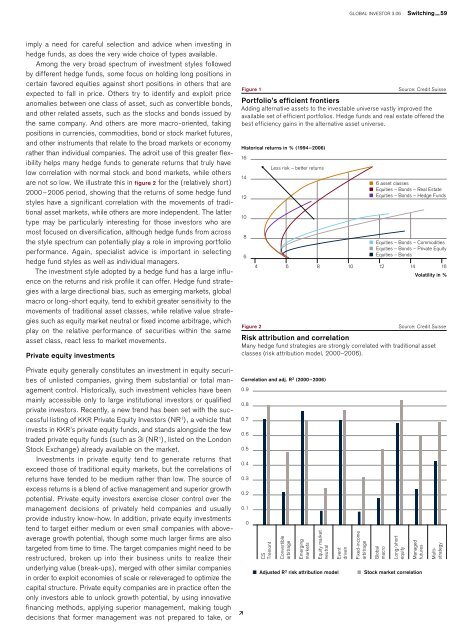Banking for 7 billion and 7 million
New challenges and opportunities of globalization Global Investor, 03/2006 Credit Suisse
New challenges and opportunities of globalization
Global Investor, 03/2006
Credit Suisse
You also want an ePaper? Increase the reach of your titles
YUMPU automatically turns print PDFs into web optimized ePapers that Google loves.
GLOBAL INVESTOR 3.06 Switching — 59<br />
imply a need <strong>for</strong> careful selection <strong>and</strong> advice when investing in<br />
hedge funds, as does the very wide choice of types available.<br />
Among the very broad spectrum of investment styles followed<br />
by different hedge funds, some focus on holding long positions in<br />
certain favored equities against short positions in others that are<br />
expected to fall in price. Others try to identify <strong>and</strong> exploit price<br />
anomalies between one class of asset, such as convertible bonds,<br />
<strong>and</strong> other related assets, such as the stocks <strong>and</strong> bonds issued by<br />
the same company. And others are more macro-oriented, taking<br />
positions in currencies, commodities, bond or stock market futures,<br />
<strong>and</strong> other instruments that relate to the broad markets or economy<br />
rather than individual companies. The adroit use of this greater flexibility<br />
helps many hedge funds to generate returns that truly have<br />
low correlation with normal stock <strong>and</strong> bond markets, while others<br />
are not so low. We illustrate this in figure 2 <strong>for</strong> the (relatively short)<br />
2000 – 2006 period, showing that the returns of some hedge fund<br />
styles have a significant correlation with the movements of traditional<br />
asset markets, while others are more independent. The latter<br />
type may be particularly interesting <strong>for</strong> those investors who are<br />
most focused on diversification, although hedge funds from across<br />
the style spectrum can potentially play a role in improving portfolio<br />
per<strong>for</strong>mance. Again, specialist advice is important in selecting<br />
hedge fund styles as well as individual managers.<br />
The investment style adopted by a hedge fund has a large influence<br />
on the returns <strong>and</strong> risk profile it can offer. Hedge fund strategies<br />
with a large directional bias, such as emerging markets, global<br />
macro or long-short equity, tend to exhibit greater sensitivity to the<br />
movements of traditional asset classes, while relative value strategies<br />
such as equity market neutral or fixed income arbitrage, which<br />
play on the relative per<strong>for</strong>mance of securities within the same<br />
asset class, react less to market movements.<br />
Private equity investments<br />
Figure 1<br />
Source: Credit Suisse<br />
Portfolio’s efficient frontiers<br />
Adding alternative assets to the investable universe vastly improved the<br />
available set of efficient portfolios. Hedge funds <strong>and</strong> real estate offered the<br />
best efficiency gains in the alternative asset universe.<br />
Historical returns in % (1994–2006)<br />
16<br />
14<br />
12<br />
10<br />
8<br />
6<br />
Figure 2<br />
Less risk – better returns<br />
6 asset classes<br />
Equities – Bonds – Real Estate<br />
Equities – Bonds – Hedge Funds<br />
Equities – Bonds – Commodities<br />
Equities – Bonds – Private Equity<br />
Equities – Bonds<br />
4 6 8 10 12 14 16<br />
Volatility in %<br />
Source: Credit Suisse<br />
Risk attribution <strong>and</strong> correlation<br />
Many hedge fund strategies are strongly correlated with traditional asset<br />
classes (risk attribution model, 2000–2006).<br />
Private equity generally constitutes an investment in equity securities<br />
of unlisted companies, giving them substantial or total management<br />
control. Historically, such investment vehicles have been<br />
mainly accessible only to large institutional investors or qualified<br />
private investors. Recently, a new trend has been set with the successful<br />
listing of KKR Private Equity Investors (NR 1 ), a vehicle that<br />
invests in KKR’s private equity funds, <strong>and</strong> st<strong>and</strong>s alongside the few<br />
traded private equity funds (such as 3i (NR 1 ), listed on the London<br />
Stock Exchange) already available on the market.<br />
Investments in private equity tend to generate returns that<br />
exceed those of traditional equity markets, but the correlations of<br />
returns have tended to be medium rather than low. The source of<br />
excess returns is a blend of active management <strong>and</strong> superior growth<br />
potential. Private equity investors exercise closer control over the<br />
management decisions of privately held companies <strong>and</strong> usually<br />
provide industry know-how. In addition, private equity investments<br />
tend to target either medium or even small companies with aboveaverage<br />
growth potential, though some much larger firms are also<br />
targeted from time to time. The target companies might need to be<br />
restructured, broken up into their business units to realize their<br />
underlying value (break-ups), merged with other similar companies<br />
in order to exploit economies of scale or releveraged to optimize the<br />
capital structure. Private equity companies are in practice often the<br />
only investors able to unlock growth potential, by using innovative<br />
financing methods, applying superior management, making tough<br />
decisions that <strong>for</strong>mer management was not prepared to take, or<br />
0.9<br />
0.8<br />
0.7<br />
0.6<br />
0.5<br />
0.4<br />
0.3<br />
0.2<br />
0.1<br />
<br />
Correlation <strong>and</strong> adj. R 2 (2000–2006)<br />
0<br />
CS<br />
Tremont<br />
Convertible<br />
arbitrage<br />
Emerging<br />
markets<br />
Equity market<br />
neutral<br />
Adjusted R 2 risk attribution model<br />
Event<br />
driven<br />
Fixed-income<br />
arbitrage<br />
Global<br />
macro<br />
Long/short<br />
equity<br />
Managed<br />
futures<br />
Stock market correlation<br />
Multistrategy

















